
Click to enlarge 12,000 years ago, Paleoindians arrive at The Geysers. They
are the earliest-known human inhabitants of the region.
Early explorers record finding six Native American tribes living in the region.
The tribes share access to The Geysers, which they use for healing and ceremony.
No one knows how long these tribes had lived here, but we do know that their descendants
still live in the area today.
While hunting a grizzly bear, William Bell Elliott stumbles upon the "Gates to Hades."
He calls the place "The Geysers," though in fact there are no geysers here.
First tourists to The Geysers sleep in cloth houses.
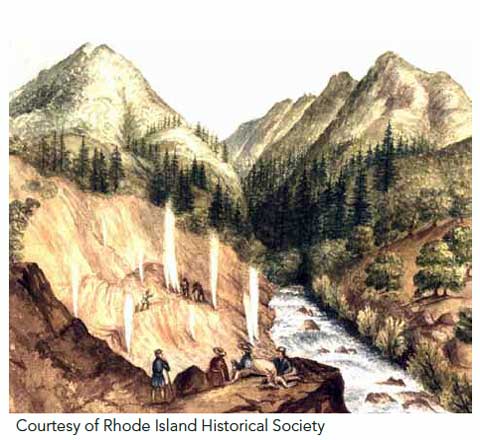
Click to enlarge U.S. Boundary Commissioner John Bartlett creates the earliest
known illustrations of The Geysers.
Construction begins on the first wing of The Geysers Resort Hotel.

Click to enlarge The Geysers is in its prime as a major tourist destination,
with famous visitors from around the world.
Sonoma County funds construction of a road to the mercury boomtown of Pine Flat,
which years later in 2003 will be the route for the Santa Rosa Geysers Recharge
Pipeline to The Geysers.
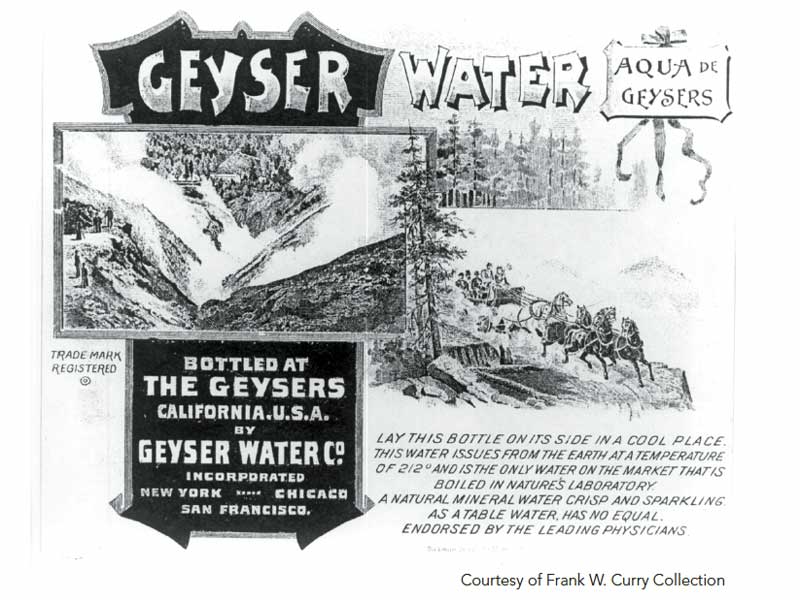
Click to enlarge Mineral Water is bottled at The Geysers. It will soon be
sold around the world.
Utilizing a small steam-engine generator, John C. Grant successfully produces electricity
at The Geysers. He acquires a lease for The Geysers Resort, hoping to generate electrical
power from steam to sell to Healdsburg and Cloverdale.
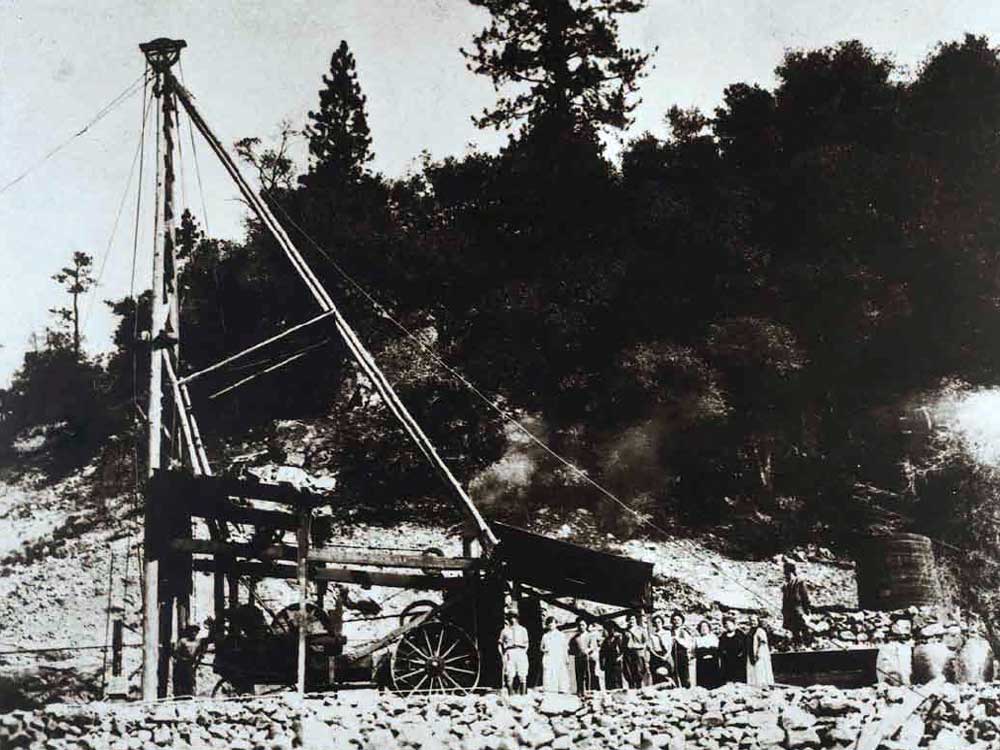
Click to enlarge Grant’s first attempt to drill a geothermal well results
in a blowout. In 1922, Grant’s second well, only 200 feet deep, is the first successful
geothermal well at The Geysers.
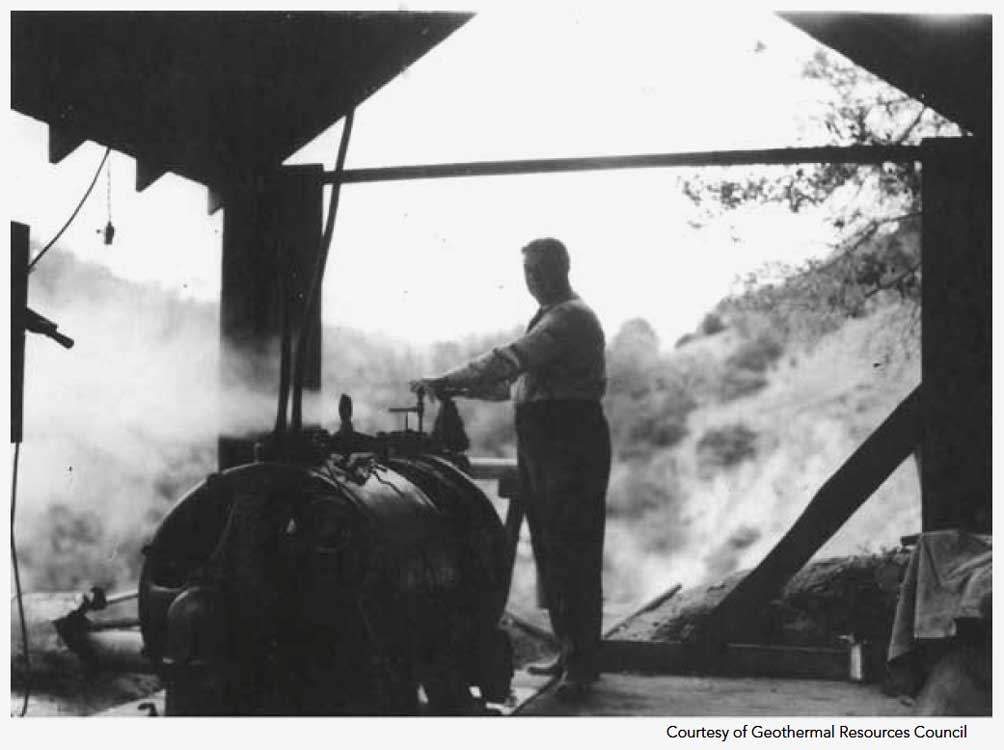
Click to enlarge Grant and his family organize The Geysers Development Company
and build a 35 kilowatt power plant, generating the first geothermal electricity
in the Americas.
The Carnegie Institution does the first study of The Geysers steam reservoir utilizing
data from the wells drilled by Grant.
Surface rights to public lands in the region are sold to private individuals for
ranching and hunting clubs. The government keeps the mineral rights, and to this
day, steam production royalties are paid to the federal and state governments and
private landowners.
Grant’s experiment with geothermal power fails due to competition from cheap oil,
but it is only a temporary setback. In modern times, The Geysers Development Company
goes on to become the most productive leaseholder in The Geysers.
The main building at The Geysers Hotel is destroyed by a landslide and fire.
George F. Curry becomes manager of The Geysers Resort Hotel. In 1957, he purchases
the property, which he operates until its closing in 1978.
Magma Power Company drills Magma 1, the first modern geothermal well at The Geysers,
on land leased from The Geysers Development Company
Thermal Power Company joins with Magma Power Company to form the joint development
venture "Magma-Thermal."
Disaster strikes The Geysers Hotel again as fire destroys the main buildings.
Pacific Gas and Electric Company (PG&E) agrees to purchase steam from Magma-Thermal.
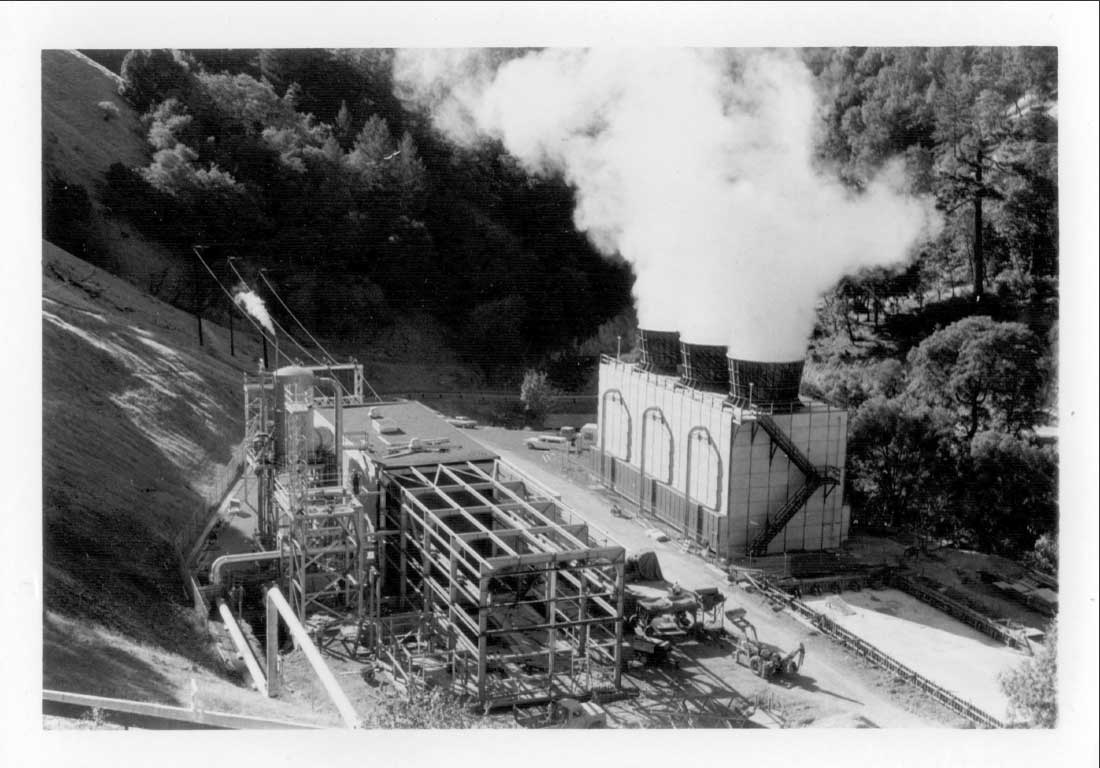
Click to enlarge PG&E completes Unit 1, the first commercial geothermal
electric unit in the Western Hemisphere, generating 11 megawatts of electricity.
Electrical generation capacity at The Geysers reaches 82 megawatts.
Geothermal wells reach 7,000 to 8,000 feet in depth. Development at The Geysers
booms, attracting many different companies looking to operate the steamfield or
build power plants.
The Geysers Resort Hotel is razed and the tourism era comes to an end.
Northern California Power Agency (NCPA) with two geothermal power plants at The
Geysers, assumes the role of field operator, power generator and franchised utility.
Production peaks at The Geysers. Twenty-one power plants are in operation, with
a total installed capacity of 2,043 megawatts. Over the next eight years, power
generation rapidly declines as a result of pressure loss in the steam reservoir.
PG&E retires Unit 15, and power plant expansion at The Geysers seems to be at an
end. That year, Calpine Corporation enters the power generation business at The
Geysers by purchasing a one-megawatt interest in the 20-megawatt Aidlin power plant.
Recently constructed in the northwest fringe of the geothermal reservoir, the Aidlin
plant is generally assumed at the time to mark the end of power plant expansion
in The Geysers.
Geysers operators begin cooperative studies on the use of augmented water injection
to create steam, sustain reservoir pressure and maintain power generation.
Calpine acquires two Geysers power plants, Bear Canyon and West Ford Flat, with
a combined average output of 43 megawatts. Calpine expands its ownership interest
in southeast Geysers steamfields.
PG&E retires Units 1, 2, 3 and 4, routing more steam to Unit 5/6.
Calpine, NCPA and Lake County Sanitation agree to construct the Southeast Geysers
Effluent Pipeline (SEGEP), a 29-mile pipeline to deliver treated wastewater to The
Geysers.
Central California Power Agency Units 1 and 2 are retired.
SEGEP is completed, bringing 9 million gallons a day of treated wastewater from
Lake County to The Geysers, where it is injected into the reservoir to increase
steam pressure.
Calpine acquires the 72 megawatt Sonoma Power Plant from Sacramento Municipal Utilities
District.
Calpine acquires 19 Geysers power plants and associated steamfields. Consolidated
ownership eliminates contractual barriers, allowing a fieldwide approach to sustainably
managing The Geysers geothermal resource.
Calpine constructs pipeline inter-ties (crossovers) linking steamfields and power
plants, minimizing the need to vent wells during plant outages. During power plant
shutdowns, the steam is diverted to other plants, reducing the loss of electrical
generation.
Calpine receives the California Department of Conservation’s Outstanding Lease and
Facility Maintenance Award for Operations at The Geysers.
Calpine and the City of Santa Rosa complete a 40-mile pipeline, bringing an average
of 11 million gallons per day of treated wastewater to The Geysers and further helping
to restore the steam reservoir.
NCPA installs the first of two, one-megawatt solar array systems to power SEGEP
pump stations.
With power plant upgrades and new sources of water to produce steam, Calpine’s electrical
generation at The Geysers stabilizes and has remained so, generating approximately
725 megawatts of baseload, renewable energy for California.
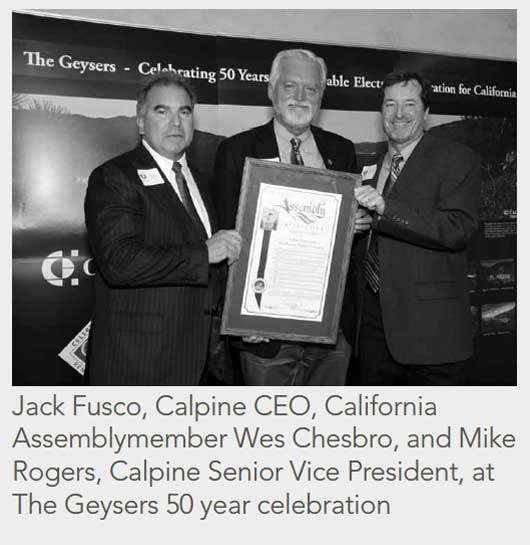
Click to enlarge The Geysers celebrates 50 years of renewable energy generation.
Calpine, the U.S. Department of Energy and Lawrence Berkeley National Laboratory
launch the Northwest Geysers Enhanced Geothermal System (EGS) Project.
The Sonoma County Board of Supervisors unanimously approves land use permits that
help pave the way for Calpine Corporation to build up to two 49 megawatt geothermal
power plants in the northwest Geysers steamfield. Calpine receives the California
Department of Conservation’s Outstanding Lease and Facility Maintenance Award for
Operations at The Geysers for the tenth consecutive year.